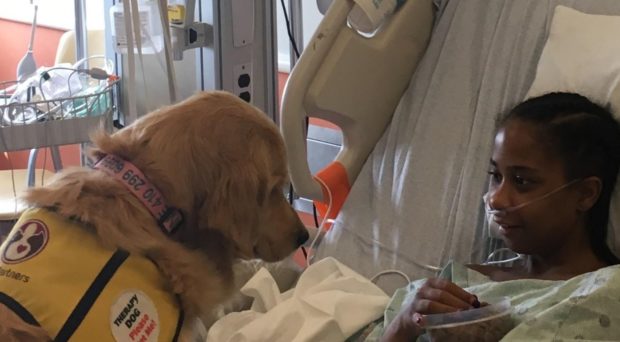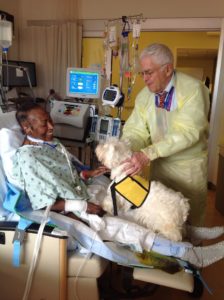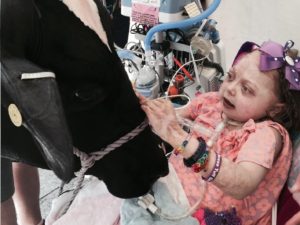
More patients are now surviving critical illness and intensive care unit (ICU) stays, but this can come at a cost, with many patients experiencing post-intensive care syndrome. This can include problems with cognition (attention, learning, memory), anxiety, depression, muscle weakness, and pain.

To reduce these negative effects, healthcare providers are looking for ways to humanize care in the ICU. Critical care practice guidelines now suggest: 1) reducing sedation, 2) increasing physical activity (for example, physical therapy or walking), and 3) changing ICU environments to promote sleep, invite family, encourage valued activities, and reduce delirium. These changes create a culture that emphasizes comprehensive care of the whole person.
To do this, providers are now looking beyond medications and medical interventions to assist patients with the fear, uncertainty and demoralization that can come with an ICU stay. One promising method is to incorporate animal-assisted activities. Studies have shown that animals can reduce anxiety, depression, blood pressure and pain, and increase engagement in rehabilitation and recovery behaviors. These findings occur in populations ranging from pediatrics to geriatrics. There is currently limited evidence about animal-assisted activities in the ICU, but anecdotes and provider narratives suggest that there is a benefit.
At our institution, we incorporate animals into ICU care when patients have a long stay, are anxious about being physically inactive while critically ill, and when they need distraction or relaxation to manage pain.
In particular, she missed her cow, Pantene, so her family and the ICU staff worked together to bring her cow to the hospital courtyard.
A favorite example is that of a pediatric ICU patient who was receiving extracorporeal support with a length of stay of over 600 days. She missed her home, a farm several hours from the hospital. In particular, she missed her cow, Pantene, so her family and the ICU staff worked together to bring her cow to the hospital courtyard. She was able to stand to kiss the cow, reach to pet, and to be outside with family. The result – an intervention to improve body, mind, and spirit.

To identify patients who are in greatest need and likely to have a successful visit, we created a brief checklist: 1) Has the patient said they would be interested in a visit? 2) Will the patient be alert enough to participate in and remember the visit? 3) Does the patient have any infection precautions that require a discussion with hospital epidemiology and infection control providers?
These visits also require multidisciplinary collaboration and planning. Input from colleagues in risk management, hospital epidemiology and infection control can be helpful when creating a hospital policy or procedure for animal-assisted intervention.
In sum, efforts to promote living fully and meaningfully while in hospital may improve long-term outcomes. Incorporating animals into patient care is, paradoxically, a great way to humanize it.
Note: all images in this blog are published with written patient consent
Comments